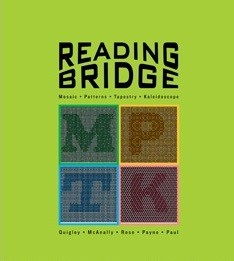*** DISCONTINUED (NO LONGER AVAILABLE) ***
Reading Bridge is a series of readers that provides a bridge from Reading Milestones to general reading materials at fourth- and fifth-grade levels. These readers are specifically constructed for deaf students and for other language-different or language-variant populations, such as students learning English a a second language.
Reading Bridge introduces vocabulary, language structures, and comprehension skills in the same spiraling, researched-based approach as in Reading Milestones but at an accelerated rate and more advanced level. The Reading Bridge readers are presented in adult-format, hard-cover books, making them more appealing to students desiring an adult-looking product.
Reading Bridge consists of four teacher's guides, four student texts, and four student workbooks. The Reading Bridge program has two levels with two books at each level. The content of each book is addressed in the teacher's guides.
Each teacher's guide contains the following features: a discussion of the foundations for Reading Bridge; a Scope and Sequence Chart for each book; activities, guidelines, and suggestions for introducing, reviewing, assessing, and reteaching specific skills; suggested questions to supplement those in the student's text; an answer key for workbook activities; and suggested enrichment activities.
Reading Bridge contains four student texts, two for each level. The texts consist of two units with seven or eight stories in each unit. The contents of both levels represent a balance of fiction and nonfiction stories, including poetry, biographies, fables, folktales, and other forms of information presentation.
Every story begins with a series of questions that teachers can use to assess, activate, and add to the prior knowledge of the students--that is, to prepare students with the background knowledge needed for application in the comprehension process. Comprehension questions are provided at the end of each story; mid-unit and end-of-unit review questions are also included. Finally, a glossary is at the back of the texts. This handy glossary gives the meaning of the new vocabulary and sample sentences that show usages of the words.
The student workbooks provide practice activities for the major components of Reading Bridge: vocabulary and concept development, comprehension, and research and study skills. To develop the workbooks, the following guidelines were used:
- Tasks should be relevant to instruction, concepts, and skills presented in the teacher's guide.
- Some tasks should provide a cumulative review of important information that has been previously taught.
- Extra activities should be available for students who need them.
- The vocabulary level of the workbooks should be similar and reinforce that used in the readers.
- All instructions should be clear, unambiguous and easy to follow.
- Student response modes should entail mostly reading and writing.
- Some tasks should be fun to do.
This engaging reading series will quickly become one of your favorite reading comprehension tools. Your students will love the variety of interesting topics enriched by attractive illustrations and photographs. They will be on their way to mainstream reading curriculum in no time with the help of the Reading Bridge series.
No additional information available for this item.

 Proud to be Canadian
Proud to be Canadian


